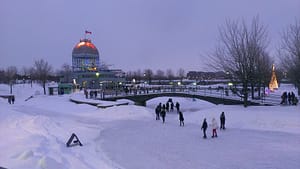Shopping in Downtown
Among natives, shopping ranks right up there with dining out as a prime activity. Many Montréalers are of French ancestry, after all, and impeccable taste must bubble up through the Gallic gene pool. The city has produced a thriving fashion industry, from couture to ready-to-wear, with a history that reaches back to the earliest trade in furs and leather.
The Best Buys
The province’s daring high-fashion designers produce appealing clothing at prices that are often reasonable. Superbly constructed furs and leather goods that recall Montréal’s long history as part of the fur trade remain high-ticket items. While not cheap, Canadian Inuit sculptures and 19th- to early-20th-century country furniture are handsome and authentic. Less expensive crafts are also available, including quilts and drawings by First Nation and other folk artists.
The Best Shopping Areas
In downtown, rue Sherbrooke is a major high-end shopping street, with international and domestic designers, luxury shops, art galleries, and the Holt Renfrew department store. Also downtown, rue Ste-Catherine is home to the city’s top department stores and mid-priced shopping—it’s the central commercial artery. From the cross street rue Aylmer, where the department store La Baie is located, Ste-Catherine heading west offers a 12-block stretch of stores that includes super-high-end jeweler Henry Birks, the moderately priced Simons department store, and the swank Ogilvy department store, where a bagpiper still announces the noon hour amid glowing chandeliers and wide aisles. International labels including Tommy Hilfiger, Kiehl’s, and H&M are all represented. Streets are crowded, and the atmosphere is frenetic. Note that Ste-Catherine also has a smattering of adult strip clubs and sex shops (usually on the second floor) right alongside the family-friendly fare. For better and for worse, Ste-Catherine’s mixed use is a Montréal signature.
Downtown’s Underground City
A unique shopping opportunity is the underground city, also known as the underground pedestrian network and officially called RÉSO (from réseau, which means network in French). It’s a mish-mash of passageways connecting shopping malls and some 1,700 stores. Most of the malls have levels both at street level and below ground. The network also connects to most subway stations downtown.
Typical of the malls is the Complexe Desjardins, in the heart of downtown. It has entrances at street level and underground, and is bounded by rues Ste-Catherine, St-Urbain, and Jeanne-Mance, and boulevard René-Lévesque. It has fountains, trees and hanging vines, lanes of 110 shops in every direction, and a fast-food court that can accommodate 1,000 people.
Navigating the underground city is a challenge: maps, signage, and even numbering of levels can differ from one section to the next. The main thing to remember is that when you enter a street-level shopping emporium downtown, it’s likely that you’ll be able to descend to a lower level and connect to the tunnels and shopping hallways that lead to another set of stores.
Shopping in Vieux-Montréal
Strolling the cobblestoned rue St-Paul in Vieux-Montréal ranks as a highlight of a visit for many travelers. The street has the aura of days gone by and is one of the most picturesque corners of Canada. It is lined on both sides with restaurants, hotels, and some avant-garde fashion and art workers.
Marché Atwater (www.marche-atwater.com), or Atwater market, west of Vieux-Montréal, is an important indoor-outdoor farmer’s market that’s open daily. French in flavor, it features fresh fruits, vegetables, and flowers along with patisseries, boulangeries, fromageries, and shops with easy-to-travel-with food. It’s a 45-minute walk, a 15-minute bike ride, or a Métro trip to Lionel-Groulx.
Shopping in Plateau Mont-Royal & Mile End
A trip to the shops in the bohemian Plateau and Mile End neighborhoods should send you home with a dash of local style. In Plateau Mont-Royal, rue St-Denis north of Sherbrooke has blocks of shops filled with fun, funky items. Boulevard St-Laurent sells everything from budget practicalities to off-the-wall handmade fashions.
For ritzier offerings, go further north: Avenue Laurier, between boulevard St-Laurent and avenue de l’Epée, is home to Parisian boutiques, furniture and accessories shops, and products from the ateliers of young Québécois designers. This is a vibrant, upscale street, with a rich selection of restaurants, too. Pop into Pâtisserie De Gascogne, 237 av. Laurier ouest, for a decadent sweet treat as part of your tour.
Montréal boasts an enviable network of vintage boutiques—it’s no secret that this is where many of Montréal’s artsy style-mavens procure their looks. Many friperies, as they’re called in French, are scattered in these neighborhoods, especially on boulevard St-Laurent near the cross street avenue Duluth and on avenue du Mont-Royal west of rue St-Denis. Also on this street is Aime Com Moi, at 150 av. du Mont-Royal est which offers enticing “créateurs quebécois”—all of its fashionable clothes are from Québec designers.

